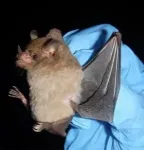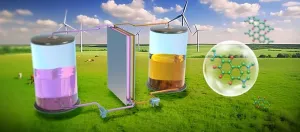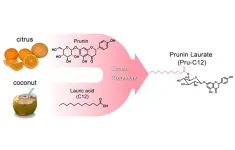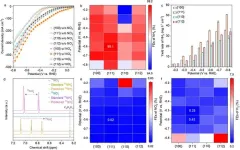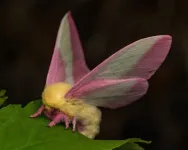(Press-News.org) KANSAS CITY, MO—August 28, 2024—Humans must regulate blood sugar concentrations to stay healthy and to fuel our cells. Too little or too much can cause serious health complications, and high blood sugar is a hallmark of the metabolic condition, diabetes. New research from the Stowers Institute for Medical Research may enable potential solutions to metabolic disease by turning to evolution and to bats.
Recently published in Nature Ecology and Evolution on August 28, 2024, the study led by co-first authors Postdoctoral Research Associate Jasmin Camacho, Ph.D., and former Stowers researcher Andrea Bernal-Rivera from the lab of Stowers Associate Investigator Nicolas Rohner, Ph.D., reports the highest naturally occurring blood sugar concentrations in mammals ever observed, a finding that suggests bats have evolved strategies to survive, and even thrive, with this extreme trait.
“Our study reports blood sugar levels that are the highest we have ever seen in nature—what would be lethal, coma-inducing levels for mammals, but not for bats,” said Camacho. “We are seeing a new trait we didn’t know was possible.”
Thirty million years ago, the Neotropical leaf-nosed bat survived solely on insects. Since then, these bats have diversified into many different species by changing what they eat. From insects, different lineages now specialize on diets ranging from fruits, nectar, meat, and everything in between—even just blood.
“Looking to animals that have existed for millions of years allows us to start to catalog changes that have happened over evolution,” said Camacho. “What makes Neotropical leaf-nosed bats so unique to study is that this group is comprised of many different species with very diverse diets, making it feasible to find answers about how diet evolves. The hope is that we can extend this understanding to other mammals, including humans, where there may be ways to learn how to better protect our own health.”
To uncover how bats diversified their diets, the team traveled to the jungles of Central America, South America, and the Caribbean to conduct fieldwork over several years. These catch-and-release expeditions were focused on performing glucose tolerance tests—measuring the concentration of sugar in blood—on nearly 200 wild-caught bats across 29 species after a single feeding of one of three types of sugars associated with diets of insects, fruits, or nectar.
“We saw various ways sugar is assimilated—absorbed, stored and used in the body—and how this process has become specialized due to different diets,” said Bernal-Rivera.
The mechanism for maintaining blood sugar levels within a narrow, healthy range is called glucose homeostasis, which is typically regulated by the hormone insulin and is what goes awry in diabetes. Different species of leaf-nosed bats reveal a spectrum of adaptations to glucose homeostasis, ranging from changes in intestinal anatomy to genetic alterations for proteins that transport sugar from blood to cells.
“Fruit bats have honed their insulin signaling pathway to lower blood sugar,” said Camacho. “On the other extreme, nectar bats can tolerate high blood glucose levels, similar to what is observed in people with unregulated diabetes. They have evolved a different mechanism, and it does not seem to depend on insulin.”
Although precisely how nectar bats are managing glucose is still under investigation, the researchers found potential clues for alternative metabolic strategies for glucose regulation. Bats with sugar-rich diets were observed to have longer portions of their intestines and to have intestinal cells with greater surface areas for absorbing nutrients from food, compared to bats with other diets. In addition, nectar bats, unique from fruit bats, have a continual expression of a gene responsible for sugar transport, a trait also observed in a species of hummingbird.
“This study establishes extremely important resources for the field,” said Nadav Ahituv, Ph.D., a bioengineering and genetics professor at the University of California, San Francisco. “It provides not only metabolic characteristics of various bat species with different diets, but also their intestinal morphology, and candidate genomic regions and protein structural differences that could be driving dietary adaptations.”
“The datasets will fuel future research that aims to differentiate mammalian dietary differences and could progress the development of novel therapeutics for a variety of metabolic diseases in humans,” said Ahituv.
Additional authors include Valentina Peña, Sofia Robb, Ph.D., Jonathon Russell, Kexi Yi, Ph.D., Yongfu Wang, Ph.D., Dai Tsuchiya, Ph.D., and Oscar Murillo-García, Ph.D.
This work was supported by the National Science Foundation’s Postdoctoral Research Fellowships in Biology (award: 2109717), the Burroughs Wellcome Fund Postdoctoral Diversity Enrichment Program (award: G-1022339), the Howard Hughes Medical Institute Hanna H. Gray Fellows Program (award: GT15991), and by institutional support from the Stowers Institute for Medical Research. A portion of fieldwork performed for this study was supported by Contribución a la conservación del Bosque seco Tropical del Valle del Cauca (CVC permit: 1122) from the Institute for Research and Preservation of the Cultural and Natural Heritage of Valle del Cauca.
END
Bats are surviving and thriving on nothing but sugar
Scientists recorded the highest natural blood sugar levels ever observed in a mammal, now they hope it could help them better understand diabetes
2024-08-28
ELSE PRESS RELEASES FROM THIS DATE:
Researchers develop novel organic redox-active molecules for flow batteries
2024-08-28
Organic redox-active molecules (ORAMs) are abundant and diverse, offering significant potential for cost-effective and sustainable energy storage, particularly in aqueous organic flow batteries (AOFBs). However, ensuring the stability of the ORAMs during the charge and discharge process is critical, as side reactions can deactivate them and eliminate their redox activity. Air stability remains a challenge for many ORAMs, complicating their practical use.
Recently, a research group led by Prof. LI Xianfeng and Prof. ZHANG Changkun from ...
Study finds limits to storing CO2 underground to combat climate change
2024-08-28
Imperial College London press release
Under strict embargo until:
Wednesday 28 August 2024
10am UK time/5am Eastern
Study finds limits to storing CO2 underground to combat climate change
Imperial research has found limits to how quickly we can scale up technology to store gigatonnes of carbon dioxide under the Earth’s surface.
Current international scenarios for limiting global warming to less than 1.5 degrees by the end of the century rely on technologies that remove carbon dioxide (CO2) from the Earth’s atmosphere faster than humans release it. This means removing ...
Pain identified as dominant symptom in long Covid
2024-08-28
Pain may be the most prevalent and severe symptom reported by individuals with long Covid, according to a new study led by UCL (University College London) researchers.
The study, published in JRSM Open, analysed data from over 1,000 people in England and Wales who logged their symptoms on an app between November 2020 and March 2022.
Pain, including headache, joint pain and stomach pain, was the most common symptom, reported by 26.5% of participants.
The other most common symptoms were neuropsychological ...
What role did fear play in Europe's population growth?
2024-08-28
[Vienna, August 26 2024] – Since the end of the last Ice Age, growth of human population was far from uniform, marked instead by periods of rapid expansion followed by sharp declines. The reasons behind these fluctuations remain only partially understood. Previous research by CSH scientists Peter Turchin, Daniel Kondor, and an international team of collaborators, demonstrated that social conflicts, rather than – or in addition to – environmental factors, could have significantly impacted these patterns. Now, they add another piece to the puzzle.
Wars and conflicts not only cause direct casualties but also create an atmosphere of distress ...
Shot of confidence: Building trust in vaccination programs
2024-08-28
A new paper in the Journal of Public Health, published by Oxford University Press, finds that highlighting the harms of not getting vaccinated is a more effective message than emphasizing the benefits of vaccination for individual patients or the benefits to public health.
Vaccination remains the most economical and effective public health strategy for reducing morbidity and mortality. But some vaccines, such as those for flu, pneumonia and HPV, are given voluntarily. Often due to misinformation or ignorance many people are reluctant to get vaccinated for various diseases (or to vaccinate their children). For years researchers have been investigating various strategies ...
Protect your teeth with fruit: antimicrobial effects found in biomass compounds
2024-08-28
Periodontal disease is an inflammatory disease caused by a periodontal pathogenic bacteria infection that affects oral and internal health. Good oral care is essential for prevention, but most over-the-counter oral hygiene products are disinfectants that can be highly irritating. This makes them unsuitable for use by young children and the elderly, who are susceptible to periodontal disease.
To find an antibacterial that is easy to use and effective in preventing periodontal disease at all ages, Professor Shigeki Kamitani of Osaka Metropolitan University’s Graduate School of Human Life and Ecology led a research team in verifying the antibacterial effect of seven ...
AI tools like ChatGPT popular among students who struggle with concentration and attention
2024-08-28
Since their release, AI tools like ChatGPT have had a huge impact on content creation. In schools and universities, a debate about whether these tools should be allowed or prohibited is ongoing.
Now, researchers in Sweden have investigated the relationship between adolescents’ EF and their use and perceived usefulness of generative AI chatbots for schoolwork. They published their results in Frontiers in Artificial Intelligence.
“Students with more EF challenges found these tools particularly useful, especially for completing assignments,” said Johan Klarin, a school psychologist and research assistant at the Department of Psychology ...
Insights into spinel cobalt oxides may lead to efficient ammonia synthesis
2024-08-28
Researchers have made a significant breakthrough in the development of catalysts for the electrochemical nitrate reduction reaction (eNO₃RR) to ammonia, a process that has broad implications for sustainable energy, agriculture, and industrial applications.
Ammonia, a critical component in global food production, also holds promise as a zero-carbon fuel due to its high energy density, clean combustion products, and established infrastructure for storage and transportation. However, the current method of producing ...
U of A College of Nursing receives $1.6M grant to support Indigenous students
2024-08-28
Indigenous students pursuing nursing careers at the University of Arizona College of Nursing will benefit from additional financial support thanks to a $1.6 million grant from the U.S. Department of Health and Human Services’ Indian Health Service.
The grant will fund the successful Indians in Nursing: Career Advancement and Transition Scholars, or INCATS, program for another five years. The program provides Indigenous students at the U of A College of Nursing with financial support for tuition, fees and a living stipend.
Additionally, the grant provides resources for dedicated time and personnel to partner with tribal ...
Moths may use disco gene to regulate day/night cycles
2024-08-28
How does one species become two? If you’re a biologist, that’s a loaded question. The consensus is that, in most cases, the process of speciation occurs when individuals from a single population become geographically isolated. If they remain separate long enough, they lose the ability to interbreed.
A new study published in the journal Proceedings of the Royal Society B: Biological Sciences demonstrates what happens when a less common form of speciation occurs. Rather than being separated by a physical barrier, such as a mountain range or an ocean, members of a species can become ...
LAST 30 PRESS RELEASES:
How does age affect recovery from spinal cord injury?
Novel AI tool offers prognosis for patients with head and neck cancer
Fathers’ microplastic exposure tied to their children’s metabolic problems
Research validates laboratory model for studying high-grade serous ovarian cancer
SIR 2026 delivers transformative breakthroughs in minimally invasive medicine to improve patient care
Stem Cell Reports most downloaded papers of 2025 highlight the breadth and impact of stem cell research
Oxford-led study estimates NHS spends around 3% of its primary and secondary care budget on the health impacts of heat and cold in England
A researcher’s long quest leads to a smart composite breakthrough
Urban wild bees act as “microbial sensors” of city health.
New study finds where you live affects recovery after a hip fracture
Forecasting the impact of fully automated vehicle adoption on US road traffic injuries
Alcohol-related hospitalizations from 2016 to 2022
Semaglutide and hospitalizations in patients with obesity and established cardiovascular disease
Researchers ‘listen in’ to embryo-mother interactions during implantation using a culture system replicating the womb lining
How changing your diet could help save the world
How to make AI truly scalable and reliable for real-time traffic assignment?
Beyond fragmented markets: A new framework for efficient and stable ride-pooling
Can shape priors make road perception more reliable for autonomous driving?
AI tracks nearly 100 years of aging research, revealing key trends and gaps
Innovative techniques enable Italy’s first imaging of individual trapped atoms
KIER successfully develops Korea-made “calibration thermoelectric module” for measuring thermoelectric device performance
Diversifying US Midwest farming for stability and resilience
Emphasizing immigrants’ deservingness shifts attitudes
Japanese eels, climate change, and river temperature
Pusan National University researchers discover faster, smarter heat treatment for lightweight magnesium metals
China’s 2024 Gastroenterology Report: marked progress in endoscopy quality and disease management
Pusan National University researchers uncover scalable method for ultrahigh-resolution quantum dot displays
Researchers use robotics to find potential new antibiotic among hundreds of metal complexes
Gut bacteria changes at the earliest stages of inflammatory bowel disease
Scientists develop new way to “listen in” on the brain’s hidden language
[Press-News.org] Bats are surviving and thriving on nothing but sugarScientists recorded the highest natural blood sugar levels ever observed in a mammal, now they hope it could help them better understand diabetes

